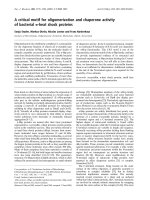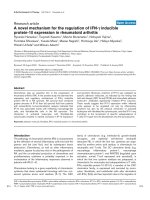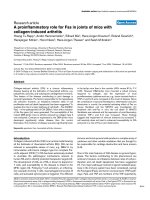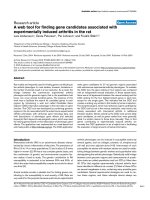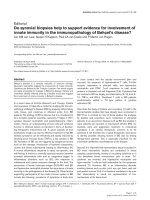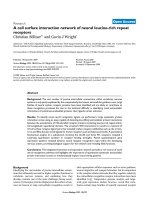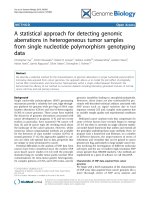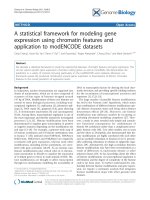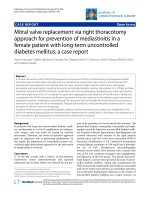Báo cáo y học: " A pilot study evaluating a support programme for parents of young people with suicidal behaviour" pot
Bạn đang xem bản rút gọn của tài liệu. Xem và tải ngay bản đầy đủ của tài liệu tại đây (241.12 KB, 8 trang )
BioMed Central
Page 1 of 8
(page number not for citation purposes)
Child and Adolescent Psychiatry and
Mental Health
Open Access
Research
A pilot study evaluating a support programme for parents of young
people with suicidal behaviour
Lorna Power*
1
, Sophia Morgan
1
, Sinead Byrne
1
, Carole Boylan
1
,
Andreé Carthy
1
, Sinead Crowley
1
, Carol Fitzpatrick
1
and Suzanne Guerin
2
Address:
1
Department of Child Psychiatry, The Children's University Hospital, Temple Street, Dublin, Ireland and
2
Department of Psychology,
University College Dublin, Ireland
Email: Lorna Power* - ; Sophia Morgan - ; Sinead Byrne - ;
Carole Boylan - ; Andreé Carthy - ; Sinead Crowley - ;
Carol Fitzpatrick - ; Suzanne Guerin -
* Corresponding author
Abstract
Background: Deliberate self harm (DSH) is a major public health concern and has increased among young
people in Ireland. While DSH is undoubtedly the result of interacting factors, studies have identified an association
between DSH and family dysfunction as well as the protective role of positive family relationships. Following a
focus group meeting held to identify the needs of parents and carers of young people with DSH, a support
programme (SPACE) was developed. The aims of the current study are to evaluate the effectiveness of the SPACE
programme in decreasing parental psychological distress, reducing parental report of young peoples' difficulties,
increasing parental satisfaction and increasing parents' ratings of their own defined challenges and goals.
Methods: Participants were recruited from a Mental Health Service within a paediatric hospital, Community
Child and Adolescent Mental Health Teams and family support services. All services were located within the
greater Dublin area in Ireland. Forty-six parents of children who had engaged in or expressed thoughts of self
harm attended the programme and participated in the evaluation study. The programme ran once a week over
an 8-week period and included topics such as information on self harm in young people, parenting adolescents,
communication and parental self-care. Seventy percent (N = 32) of the original sample at Time 1 completed
measures at Time 2 (directly following the programme) and 37% (N = 17) of the original sample at Time 1
completed them at Time 3 (6 months following the programme).
A repeated measures design was used to identify changes in parental wellbeing after attendance at the programme
as well as changes in parental reports of their children's difficulties.
Results: Participants had lower levels of psychological distress, increased parental satisfaction, lower ratings of
their own defined challenges and higher ratings of their goals directly after the programme. These changes were
maintained at 6-month follow up in the 37% of participants who could be followed up. Furthermore the young
people who had engaged in or expressed thoughts of self harm had lower levels of difficulties, as reported by their
parents, following the programme.
Conclusion: These findings suggest that the SPACE programme is a promising development in supporting the
parents of young people with suicidal behaviour. The programme may also reduce parental reports of their
children's difficulties. Further evaluation using a randomized controlled trial is indicated.
Published: 15 July 2009
Child and Adolescent Psychiatry and Mental Health 2009, 3:20 doi:10.1186/1753-2000-3-20
Received: 18 December 2008
Accepted: 15 July 2009
This article is available from: />© 2009 Power et al; licensee BioMed Central Ltd.
This is an Open Access article distributed under the terms of the Creative Commons Attribution License ( />),
which permits unrestricted use, distribution, and reproduction in any medium, provided the original work is properly cited.
Child and Adolescent Psychiatry and Mental Health 2009, 3:20 />Page 2 of 8
(page number not for citation purposes)
Background
Deliberate Self Harm (DSH) is a major public health con-
cern [1] which has become increasingly more common
among young people. The term DSH describes "an act
with a nonfatal outcome in which an individual deliber-
ately did one or more of the following: initiated behav-
iour (for example, self-cutting, jumping from a height),
which they intended to cause self-harm; ingested a sub-
stance in excess of the prescribed or generally recognised
therapeutic dose; ingested a recreational or illicit drug that
was an act that the person regarded as self-harm; ingested
a non-ingestible substance or object" [2].
In a recent study of 4,583 adolescents in Ireland, a lifetime
history of DSH was reported by 9.1% of respondents [1].
This is in contrast to a large self report survey of schools in
England where a lifetime history of DSH was reported by
13.2% of respondents [2]. The Irish study was consistent
with previous findings in that DSH was more common
among females (13.9%) than males (4.3%). The most
common methods used were cutting (66%) and taking an
overdose (35.2%). Of those who had harmed themselves,
only a minority (11.3%) had attended hospital after-
wards. This is in line with the self-report survey in England
where it was found that only 12.6% of episodes of self
harm resulted in hospital presentation [2].
DSH is a significant risk factor for suicide in that individ-
uals who take overdoses or deliberately inflict injury on
themselves and survive are at a particularly high risk of
eventually dying by suicide [3]. In addition there is an
association between DSH in young people and a range of
poor psychosocial outcomes as adults. A recent study [4]
details the early adult outcomes of 132 adolescents who
had deliberately self-poisoned. Participants were com-
pared with a matched control group who had never
harmed themselves and were randomly selected from the
waiting lists of primary care physicians. Results indicated
that rates of psychopathology, in particular depression,
were higher among those who had self-poisoned – rates of
current mental disorders were 16% in the control group
and 39% in the self-poisoning group. Furthermore the
self-poisoning group also differed to controls on a
number of other measures of social functioning and
adversity. The self-poisoning group were more likely than
controls to have experienced sexual abuse, disrupted edu-
cation, left school early without qualifications and to have
left home, cohabited and become parents at an earlier age.
Considering these associations, it is imperative to develop
effective means of identifying and managing self harm in
young people.
An episode of DSH is likely to have a negative effect on the
families of the individual involved. In a qualitative study
aimed at investigating parents' experiences after an epi-
sode of DSH in young people, parents reported feeling
very distressed, helpless and anxious about the possibility
of future episodes [5]. These concerns were perpetuated
by a perceived lack of support and information from some
health professionals. This suggests that parental support
and education should be an integral part of aftercare.
In a similar study, aimed at investigating parents' emo-
tional and behavioural responses to adolescents' suicide
attempts [6], 22 mothers and 12 fathers were assessed
soon after the event using both open-ended and struc-
tured interviews. Mothers' reactions included an increase
in sad, caring and anxious feelings with approximately
half feeling hostile after the suicide attempt. However, few
verbalized this hostility and many reported being careful
about what they said following the suicide attempt. The
authors suggest that intervention with parents should
focus on normalising their feelings and responses as well
as developing the family's communication skills with a
focus on increasing positive feedback and reducing hostile
or critical statements.
While DSH is undoubtedly the result of multiple interact-
ing factors with no one causal factor [7], there has been
much research to support an association between DSH
and poor family functioning. In a study of 20 individuals
who had engaged in DSH but who had no further epi-
sodes in the two years prior to the interview, participants
recalled unpredictability in family life at the time of self
harming [8]. They also reported having felt unsupported,
not heard and that their story was of no importance to
their family. Poor communication in particular has been
found to be associated with DSH. In a quantitative study
comparing 52 adolescents who had presented to Accident
and Emergency departments following DSH with 52 hos-
pital-based controls whom had been admitted to the hos-
pital and had no psychiatric history or self harm, there
was a strong association between the absence of a family
confidant and adolescent self harm [9]. The authors sug-
gested that poor communication within the family may
lead the young person to feel socially isolated, their prob-
lems to appear insurmountable with DSH being perceived
as their only option. Likewise, positive parental behav-
iours can serve to protect young people from DSH. In a
study of 451 families, who were participating in a longitu-
dinal research project examining rural families in the
United States, the family processes that may lead to ado-
lescent suicidality were investigated [10]. Structural equa-
tion modelling was used to examine the hypothesis that
parents' behaviour would predict their adolescents' emo-
tional distress and subsequent suicidal behaviour. Find-
ings indicated that warm and communicative behaviours
conveyed by mothers had a direct negative association
with adolescents' reporting of suicidality. These findings
again emphasize the importance of parental involvement
Child and Adolescent Psychiatry and Mental Health 2009, 3:20 />Page 3 of 8
(page number not for citation purposes)
in treating DSH and suggest that parents may benefit from
support which would include learning how to develop
and foster effective communication skills with their ado-
lescent.
Design of SPACE programme
Temple Street Children's University Hospital is a tertiary
referral teaching paediatric hospital in the centre of Dub-
lin, Ireland. Due to a marked increase in the number of
children and adolescents presenting following DSH, a
consultant-led DSH team was established in 2002.
Between 2002 and October 2008, the team assessed 458
young people aged 16 years and under, following an epi-
sode of DSH. During this time, the team identified a
strong need for a programme to support parents and car-
ers of young people who have engaged in DSH.
The SPACE (Supporting Parents and Carers) programme
was designed as a support programme for parents and car-
ers of children who have engaged in DSH. According to
the Report of the Expert Group on Mental Health Policy
in Ireland – A Vision for Change [11], service users should
become involved in every aspect of service development
and delivery. Considering this, as well as international
endorsement of service user involvement, a Focus Group
Meeting was held in order to directly establish the needs
of parents and carers of young people who have engaged
in DSH [12]. Twenty-five participants attended the meet-
ing of whom 15 were parents and ten were carers. Partici-
pants were divided into subgroups and presented with
two open ended questions a) What areas do you think a
support group should address? b) What would you like to
gain and/or learn from participating in such a support
group? Using conceptual analysis, one central theme
which emerged was a strong need for support. Parents felt
that there was a lack of available support and that the
opportunity to avail of peer support would be extremely
beneficial. Another theme which emerged was informa-
tion and education – parents were interested in learning
more about young people's mental health as well as DSH
statistics, aetiology and treatments. Other themes which
surfaced included re-establishing family communication
and boundaries, dealing with adolescent discipline issues,
and handling further threats or incidents of self harm.
Using information from the Focus Group Meeting, the
SPACE (Supporting Parents and Carers) programme was
developed. Its content is guided by the needs of the par-
ents and carers and reflects the themes which emerged. It
is a group programme which runs over an eight-week time
period. Each session involves 10–12 parents meeting with
two facilitators, who are experienced mental health pro-
fessional from the DSH team, for 90 minutes per week.
The approach is psycho-educational. Psycho-educational
programs are defined as time-limited, closed groups, con-
ducted by health professionals, for the purpose of educat-
ing and providing support to its lay membership [13].
Using presentations, video footage modelling effective
communication with adolescents, group discussion and
exercises the parents are provided with information
regarding DSH, support, and the opportunity for commu-
nication skills development. The topics for each session
are drawn from themes which emerged at the Focus
Group Meeting and include the following:
• Information on self harm in young people
• Depression in young people
• Medication – information about medication used in
treating depressive disorders in young people
• Parenting adolescents including positive communi-
cation, setting boundaries and dealing with emotional
and behavioural difficulties that can arise.
• Help with re-establishing family relationships and
boundaries after an incident of self harm.
• Advice on how to handle threats or further incidents
of self harm
• Self-care – looking after one-self as a parent by
achieving balance in life. The importance of parents
taking time off to rest and renew themselves.
• Information on resources within the community
such as help-lines, counselling services, family support
services.
A typical session involves an introduction, feedback from
the previous week, introduction of a new topic, small
group discussion, feedback to the larger group and a
'thought for the week', where parents are encouraged to
consider how the content of the week's programme might
be helpful in their interaction with their child.
Aims of the SPACE programme
The aims of the current study are to evaluate the effective-
ness of the SPACE programme in decreasing parental psy-
chological distress as measured by the General Health
Questionnaire-12; reducing young peoples' difficulties as
measured by the Parental Version of the Strengths and
Difficulties Questionnaire; increasing parental satisfac-
tion as measured by the Kansas Parenting Satisfaction
Scale and increasing parents' ratings of their own defined
challenges and goals as measured by Challenges and
Goals Scales.
Child and Adolescent Psychiatry and Mental Health 2009, 3:20 />Page 4 of 8
(page number not for citation purposes)
Methods
Study Design
This study used a repeated-measures design to identify sig-
nificant changes in well-being after treatment. The main
independent variable was time, with assessment occurring
before (Time 1) and after (Time 2) the SPACE pro-
gramme. In addition, participants were assessed at a 6-
month follow-up session (Time 3). The dependent varia-
bles include measures of parent psychological distress,
parental satisfaction with their role as parents, parents'
ratings of child's difficulties, ratings of challenges and goal
achievement.
The study was approved by the Ethics Committee of the
Children's University Hospital, Temple Street.
Participants
Participants were 46 parents of children and adolescents
(aged 16 years and under) who were attending mental
health services having engaged in or expressed thoughts of
DSH. Fourteen child care staff looking after children in
residential centres also participated in the study, but as
they differed significantly from the parents on several
baseline measures, it was concluded that they were two
distinct groups, and they have been omitted from the
remainder of the study. The resulting sample therefore
consisted of 46 parents, of whom 31 (67%) were mothers
and 15 (33%) were fathers. They were attending services
in relation to 32 young people.
With regard to the number of participants at each time-
point – 46 participants completed measures at Time 1.
70% (N = 32) of that original sample completed the meas-
ures at Time 2. These numbers decreased again at Time 3
– 37% (N = 17) of the original sample at Time 1 com-
pleted measures at Time 3.
Parents were recruited from Temple Street Children's Uni-
versity Hospital, 24 Child and Adolescent Mental Health
Teams (CAMHS) and 10 family support services through-
out Dublin. With regard to Temple Street Hospital, letters
were sent to all parents/carers of young people who had
attended the Accident & Emergency department over a
four year period (2004–2007) with self harm or suicidal
behaviour informing them about the programme and
inviting them to attend. Residential homes, CAMHS and
family support services were also informed by letter of the
programme and invited to refer parents and carers. Once
a parent or carer was referred, they were contacted by a
researcher and invited to attend the SPACE programme.
Over the course of the study 64 parents were referred, of
whom 46 (72%) subsequently attended the programme.
Young Person Characteristics
Of the 32 young people whose parents attended SPACE, 8
(25%) were male and 24 (75%) were female, with a mean
age of 13.71 years. When referrals were made to the
SPACE programme, referrers were asked to detail the type
of self harm that the young person engaged in as well as
whether the young person had engaged in previous epi-
sodes of self harm. When participants were recruited from
the hospital, this information was obtained from the DSH
database. With regard to method of DSH, overdose was
the most common (50%, N = 16) followed by cutting
(26.7%, N = 8). 13.3% (N = 4) presented with other types
such as attempted hanging or self biting and 10% (N = 3)
presented with suicidal ideation only. In one instance the
type of self harm was not specified. 20 (62.5%) of the
young people had a history of repeated self harm.
The SPACE programme ran over four cycles. Ten partici-
pants were from the first cycle, 13 from the second, 11
from the third, and 12 from the fourth.
Measures
Parents completed the following measures about them-
selves:
• The General Health Questionnaire (GHQ 12) is a
widely used self report screening tool used for the
assessment of mental well-being [14]. It is a measure
of common mental health problems/domains of
depression, anxiety, somatic symptoms, and social
withdrawal. It has well established reliability and
validity and has been shown to have internal consist-
ency reliability coefficients of 0.82 to 0.86 in most
studies [14,15].
• The Kansas Parenting Satisfaction Scale (KPS) is a 3
item self report measure designed to assess parent-sat-
isfaction with themselves as a parent, satisfaction with
the behaviour of their children and satisfaction with
their relationship with their children. The scale is
reported to have good concurrent validity – significant
correlations have been found with the Kansas Marital
Satisfaction Scale and the Rosenberg Self Esteem Scale
(0.23 to 0.55) [16].
• In addition, parents also completed Challenges and
Goals Scales [17] which required them to identify and
rate their challenges and goals at the present time.
Parents completed the following measure about their chil-
dren.
• The Strengths and Difficulties Questionnaire (SDQ)
[18] is a brief behavioural screening questionnaire for
3 to 16 year olds. It consists of 5 subscales – emotional
Child and Adolescent Psychiatry and Mental Health 2009, 3:20 />Page 5 of 8
(page number not for citation purposes)
symptoms, conduct problems, hyperactivity, peer rela-
tionship problems and pro-social behaviour. All sub-
scales except the pro-social behaviour subscale are
added together to generate a total difficulties score.
The SDQ subscales have a mean internal consistency
reliability co-efficient of 0.71, mean test retest reliabil-
ity co-efficient over 6 months of 0.62 and demon-
strates good criterion validity for predicting
psychological disorders [19].
Procedures
At the first session of the programme, parents provided
informed consent and completed the survey instruments.
At the last session the same measures were administered
again. Six months later parents were contacted and asked
to attend a booster session, at the start of which they com-
pleted the measures for the final time.
Planned Analyses
In order to identify any significant change in the depend-
ent variables over time, a series of one-way repeated Anal-
ysis of Variance tests (ANOVA) were used and alpha was
set at .05. Where significant differences were found paired
sample t-tests were used to further examine where the dif-
ferences were. Effect sizes were calculated using Cohen's d.
The sample size varied slightly across the analyses due to
instances of missing data. In order to account for this,
intention to treat analysis was also conducted. Using this
analysis it was assumed that no change occurred across
time for participants who did not complete measures at
one or all data collection points.
Results
As is common in longitudinal research, this study was the
subject to the effects of attrition. While there were 46 par-
ticipants at Time 1, this reduced to 32 at Time 2 and 17 at
Time 3. In order to evaluate the effects of attrition, a series
of independent samples t-tests were conducted to com-
pare scores on each measure between those who com-
pleted measures at Time 1 only with those who completed
measures at Time 1 and Time 2 as well as those who com-
pleted measures at all three data collection points. There
was no significant differences between these groups on
any measures apart from Rating of Challenges where there
was a significant difference (t (58) = 2.58, p = .012)
between those who completed Time 1 and Time 2 (M =
12.97) and those who completed Time 1 only (M = 9.94).
Parents who completed Time 1 and Time 2 had higher rat-
ings of their challenges than those who completed Time 1
only.
General Health Questionnaire
Before the SPACE programme, mean parental scores on
the General Health Questionnaire 12 (GHQ-12) (M =
6.33) were in the caseness range for psychological distress
(a score of 3 or above). This had fallen significantly by the
end of the programme (M = 3.16) with a further fall to
within the normal range (M = 0.88) by Time 3 (Table 1).
A one-way repeated measures ANOVA was used to iden-
tify any significant difference over time. A significant dif-
ference was found (F(2,12) = 34.8, p = .000). Intention to
treat analysis was also conducted whereby missing data
was replaced with the means for Time1 and a significant
difference was found (F(2, 44) = 13.92, p = .000).
A series of paired sample t-tests were then conducted in
order to identify where the differences were. Given that
multiple t-tests were used, Bonferroni correction for mul-
tiple comparisons was made whereby the alpha level was
divided by the number of comparisons. Using this more
conservative alpha level of 0.017, the means for Time 2
were significantly lower than the means for Time 1 with
Cohen's d of 1.39 indicating a large effect size [20]. The
95% confidence interval on the difference between means
was 1.89 – 7.68. Furthermore the means for Time 3 were
significantly lower than the means for Time 1(95% CI:
4.99 – 8.87) with Cohen's d = 2.79 indicating a very large
effect.
The relationship between child and parent factors was
investigated using a series of Mann Whitney U Tests.
When referrals were made to the SPACE programme,
referrers were asked to document whether the child had a
previous history of repeated self harm or whether this was
a first instance. Cases which had presented to Temple
Street hospital only were checked on the DSH database
which also documents whether there have been previous
episodes of DSH or not. There was a significant associa-
tion between parental psychological distress at baseline
(as measured by the GHQ-12) and previous history of
repeated self harm in the child (Z = -2.23, n = 32, p = .026)
with high levels of psychological distress associated with
previous episodes of DSH.
Strengths and Difficulties Questionnaire
The Strengths and Difficulties Questionnaire (SDQ) was
completed by each parent about their child. With regard
to child's Total Difficulties, the mean score was in the
abnormal range (17–40) at the beginning of the pro-
gramme and had decreased into the borderline range (14–
Table 1: Parental Scores on the General Health Questionnaire
12 before SPACE, after SPACE and at 6-month follow up
Time Mean SD N
1 6.33 4.1 45
2 3.16 3.9 32
3 0.88 2.47 17
Child and Adolescent Psychiatry and Mental Health 2009, 3:20 />Page 6 of 8
(page number not for citation purposes)
16) at the 6 month follow-up session. For each subscale of
the SDQ (pro-social behaviour, hyperactivity, conduct
problems, emotional difficulties, peer problems), as well
as the Total Difficulties score, means and standard devia-
tions for the overall group were calculated and are given
in Table 2.
The initial analysis focused on change over time and a
series of one-way repeated measures ANOVAs were used
to identify any significant differences. A significant differ-
ence was found for the Total Difficulties Scale (F(2,12) =
11.827, p = 0.001). Using paired samples t-tests, it was
found that the means for Time 2 and Time 3 were signifi-
cantly lower than the means for Time 1. This difference
remained significant using Intention to Treat analysis.
A significant difference was also found for the Hyperactiv-
ity subscale (F(2,12) = 4.289 p = 0.039) and the Emo-
tional Difficulties subscale (F(2, 12) = 10.264, p = 0.003.
Kansas Parenting Satisfaction Scale
Parental satisfaction increased across the three time peri-
ods. Means and standard deviations for the overall group
on the Kansas Parenting Scale (KPS) were calculated and
are presented in Table 3.
A one way repeated ANOVA was used to identify any sig-
nificant difference over time. A significant difference was
found (F(2,12) = 30.01, p = .000). The means for Time 3
were significantly higher than the means for Time 1 and
Time 2. Using Intention to Treat analysis, these statisti-
cally significant results remained.
Challenges & Goals Scale
Parents' ratings of their challenges decreased across the
three time periods. Means and standard deviations for the
overall group on the Challenges and Goals scale were cal-
culated and are displayed in Table 4.
With regard to parents ratings of their challenges, a one
way repeated ANOVA revealed that there was a significant
difference over time (F(2,5) = 13.68, p = 0.009). The
means for Time 1 were significantly higher than the
means for Time 2 and Time 3. Parents' ratings of their
goals also increased across the three time periods. A one
way repeated ANOVA revealed that there was a significant
difference over time (F (2,5) = 6.003, p = .047). The
means for Time 2 and Time 3 were significantly higher
than the means for Time 1. These results remained signif-
icant using Intention to Treat analysis.
Discussion
This article describes a pilot study evaluating the SPACE
programme, a group programme designed to support par-
ents and carers of children and adolescents with Deliber-
ate Self Harm. The study indicates positive results for the
parents who completed the programme. Parents had
lower levels of psychological distress, higher levels of
parental satisfaction, lower ratings on their own defined
challenges, and higher ratings of their goals after the pro-
gramme, and these gains were maintained 6 months after
the programme. Parents also reported that their young
people had lower levels of total difficulties, hyperactivity
and emotional problems following their parent's attend-
ance of the programme. When the principle of Intention
to Treat was applied, results remained statistically signifi-
cant. The fact that this more conservative approach
yielded significance only serves to heighten the impact of
these findings.
Of particular note is the high number of parents who met
the criteria for psychological distress (76%) at Time 1.
While this level of psychological distress may reflect par-
ents' reaction to their child's self-harm, it is also possible
that it reflects underlying parental psychiatric disorder
and psychological distress, which have been shown to be
common in families of suicidal young people [21,22].
Either way this psychological distress is likely to be perpet-
uated by the lack of support available to parents and car-
ers of young people with DSH. It also emphasizes the
importance of developing a programme such as SPACE to
provide this much needed support to parents and carers
and help to alleviate such feelings. Furthermore, parents
whose child had a previous history of self harm were
found to have higher levels of psychological distress so
perhaps the SPACE programme would be particularly
beneficial to these individuals.
Table 2: Parental scores on the Strengths and Difficulties Questionnaire before SPACE, after SPACE and at 6 month follow up
Time 1 Time 2 Time 3
Mean SD N Mean SD N Mean SD N
Total Difficulties 20.15 5.19 46 17.41 6.31 32 15.06 8.36 17
Pro-Social Behaviour 6.09 2.3 46 6.38 2.67 32 6.2 3.22 17
Hyperactivity 5.8 2.19 46 5.44 2.42 32 4.71 2.73 17
Conduct Problems 4 2.07 46 3.69 2.15 32 2.76 2.44 17
Emotional Difficulties 6.93 1.89 46 5.63 2.86 32 4.88 2.96 17
Peer Problems 3.41 2.15 46 2.66 2.35 32 2.53 2.24 17
Child and Adolescent Psychiatry and Mental Health 2009, 3:20 />Page 7 of 8
(page number not for citation purposes)
With regard to the profile of DSH in the 32 young people
involved in the study, the male to female ratio reflects that
of a large survey of Irish adolescents [1], whereby females
were three times more likely to harm themselves than
males. In the present study, overdose was the most com-
mon method of DSH. This is in contrast to the Irish survey
where cutting was the most frequently used method.
However this discrepancy is consistent with previous stud-
ies whereby cutting was found to be more prevalent
amongst a community sample of adolescents [2], while
rates of overdosing have been found to be higher in a clin-
ical sample [23].
The findings of the current study suggest that the SPACE
programme may be beneficial to parents. However the
study was subject to limitations and further evaluation is
required in order to conclude this. The study has three sig-
nificant limitations; the lack of a control group, the lack of
information about other interventions which the families
may have been receiving, and the high attrition rate. In
order to conclude that the SPACE programme is effective
it would be necessary to compare it with a group of par-
ents receiving no treatment and/or a group who receive a
different treatment. Participants would need to be ran-
domly assigned to conditions in order to ensure that any
group biases are evenly distributed. Future research
should attempt to identify and quantify any other treat-
ment or support that parents receive during the course of
the SPACE programme and subsequently control for this.
Such a study is currently planned.
As with most longitudinal research carried out in 'real
world' clinical settings, the current study was subject to
the effects of attrition. Analyses indicated that those who
only completed measures at Time 1 did not differ signifi-
cantly from other participants on any measures other than
Rating of Challenges. Those who completed measures at
Time 1 and Time 2 had higher ratings of their own defined
challenges compared with those who completed measures
at Time 1 only. It is possible that that those who perceived
their challenges as greater felt that the group was an
important support to them and so continued attending in
order to help them to overcome their difficulties. By
applying an 'intention to treat' analysis which also
showed significant results, we have attempted to address
the difficulty presented by the high attrition rate. It may be
beneficial for future evaluation studies to adopt a preven-
tive approach to attrition. One possibility would be to
obtain a facilitator's rating of parent participation in the
group. This data would be used to form a profile of par-
ents who drop out and could be used to alert facilitators
to potential 'drop outs' through observation of the group
[24].
The participants in this study were parents whose child
had been referred to a specialist service or who had pre-
sented to an Accident and Emergency department. This
makes it difficult to generalize the findings to other par-
ents whose children engage in DSH. Considering that
only a minority of adolescents (11.3%) attend medical
services following DSH, our sample may represent a small
proportion of parents of young people with DSH, and
may not relate to parents of young people with DSH
which does not come to medical attention.
It is anticipated that these limitations will be addressed in
a future study which is being developed. This will involve
a randomized controlled trial in which the SPACE pro-
gramme will be extended to the wider community and
will be available to parents who are not in contact with
services as well as those who are. Such a study will be able
to ensure the generalisability of findings and will address
questions regarding comparisons between families who
attend health services following DSH with those who do
not. Considering that a need identified at the Focus Group
Meeting was that of re-establishing communication, the
randomized controlled trial will include the communica-
tion subscale of the McMaster Family Assessment which
incorporates items pertaining to communication within
the family [25].
Conclusion
In conclusion, these findings suggest that the SPACE pro-
gramme may be an effective means of support for parents
of young people with Deliberate Self Harm. Parents who
Table 3: Parental scores on the Kansas Parenting Satisfaction
Scale before SPACE, after SPACE and at 6 month follow up
Time Mean SD N
1 12.13 3.21 45
2 13.48 3.48 31
3 15 3.48 17
Table 4: Parental ratings of Challenges & Goals before SPACE, after SPACE and 6 months following SPACE
Time 1Time 2Time 3
Mean SD N Mean SD N Mean SD N
Challenges 12.76 3.84 46 8.88 3.95 24 6.65 3.82 13
Goals 6.14 2.93 46 10.66 4.18 22 11.35 4.65 13
Publish with Bio Med Central and every
scientist can read your work free of charge
"BioMed Central will be the most significant development for
disseminating the results of biomedical research in our lifetime."
Sir Paul Nurse, Cancer Research UK
Your research papers will be:
available free of charge to the entire biomedical community
peer reviewed and published immediately upon acceptance
cited in PubMed and archived on PubMed Central
yours — you keep the copyright
Submit your manuscript here:
/>BioMedcentral
Child and Adolescent Psychiatry and Mental Health 2009, 3:20 />Page 8 of 8
(page number not for citation purposes)
completed the programme experienced positive gains
afterwards which were maintained 6 months later. Future
research will aim to address some of the limitations asso-
ciated with the present study such as the ability to gener-
alise from this sample, the lack of a control group, the
small sample size and high attrition rate. However these
preliminary results suggest that SPACE is a promising
development in providing support for parents of young
people with Deliberate Self Harm.
Competing interests
The authors declare that they have no competing interests.
Authors' contributions
LP was involved in the data collection, statistical analysis
and drafted the manuscript. SM and SB participated in the
design of the study, data collection and statistical analysis.
CB, SC, AC and CF ran the SPACE groups. CF was
involved in the conception of the study, participated in its
supervision, design and co-ordination as well as critically
revising the final draft of the manuscript. SG participated
in the design of the study, statistical analysis and interpre-
tation of data. All authors have read and approved the
final manuscript.
Acknowledgements
The authors would like to acknowledge the Fundraising Department of the
Children's University Hospital, Temple Street and the ESB in funding this
project.
References
1. Morey C, Corcoran P, Arensman A, Perry IJ: The prevalence of
self reported deliberate self harm in Irish adolescents. BMC
Public Health 2008, 8:79.
2. Hawton K, Rodham K, Evans E, Weatherall R: Deliberate self harm
in adolescents: Self report survey in schools in England. BMJ
2002, 325:1207-11.
3. Cooper J, Kapur N, Webb R, Lawlor M, Guthrie E, Mackway-Jones K,
Appleby L: Suicide after Deliberate Self Harm: A 4 year
cohort study. Am J Psychiatry 2005, 162:297-303.
4. Harrington R, Pickles A, Aglan A, Harrington V, Burroughs H, Kerfoot
M: Early adult outcomes of adolescents who deliberately poi-
soned themselves. J Am Acad Child Adolesc Psychiatry. 2006,
45(3):337-345.
5. Raphael H, Clarke G, Kumar S: Exploring parents' responses to
their child's deliberate self harm. Health Educ J 2006, 106:9-20.
6. Wagner BM, Aiken C, Mullaley PM, Tobin JJ: Parent's reactions to
adolescents' suicide attempts. J Am Acad Child Adoles Psychiatry
2000, 39:429-436.
7. Fergusson DM, Woodward LJ, Horwood LJ: Risk factors and life
processes associated with the onset of suicidal behaviour
during adolescence and early adulthood. Psychol Med 2000,
30:23-39.
8. Sinclair J, Green J: Understanding resolution of deliberate self
harm: Qualitative interview study of patients' experiences.
BMJ 2005, 330:1112.
9. Tulloch AL, Blizzard L, Pinkus Z: Adolescent-parent communica-
tion in self harm. J Adolesc Health 1997, 21:267-275.
10. Connor JJ, Rueter MA: Parent-child relationships as systems of
support or risk for adolescent suicidality. J Fam Psychol 2006,
20:143-155.
11. Department of Health and Children: A Vision for Change: Report
of the Expert Group on Mental Health Policy. Dublin: Health
Service Executive; 2006.
12. Byrne S, Morgan S, Fitzpatrick C, Boylan C, Crowley S, Gahan H,
Howley J, Staunton D, Guerin S:
Deliberate self harm in children
and adolescents: A qualitative study exploring the needs of
parents and carers. Clin Child Psychol Psychiatry 2008,
13(4):493-504.
13. Walsh J: Methods of psycho-educational program evaluation
in mental health settings. Patient Educ Couns 1992, 19:205-218.
14. Goldberg D, Williams H: General Health Questionnaire (GHQ-12)
Windsor, Nfer-Nelson; 1988.
15. Goldberg D, Gater R, Sartorious N, Uston T, Piccinelli M, Gureje O,
Rutter C: The validity of two versions of the GHQ in the
WHO study of mental illness in general health care. Psychol
Med 1997, 27:191-197.
16. James DE, Schumm WR, Kennedy CE, Grigsby CC, Shectman KL,
Nichols CW: Characteristics of the Kansas parental satisfac-
tion scale among two samples of married parents. Psychol Rep
1985, 57:163-69.
17. Sharry J, Guerin S, Griffin C, Drumm M: An evaluation of the Par-
ents Plus early years programme: A video based early inter-
vention for parents of pre-school children with behavioural
and developmental difficulties. Clin Child Psychol & Psychiatr 2005,
10:319-336.
18. Goodman R: The Strengths and Difficulties Questionnaire: A
Research Note. J Child Psychol Psychiatry. 1997, 38(5):581-586.
19. Goodman R: Psychometric properties of the Strengths and
Difficulties Questionnaire (SDQ). J Am Acad Child Psy 2001,
40:1337-1345.
20. Cohen J: A power primer. Psychol Bull 1992, 112:155-159.
21. Houston K, Hawton K, Shepperd R: Suicide in young people aged
15–24: A psychological autopsy study. J Affect Disorders 2001,
63:159-170.
22. Brent DA: Risk factors for adolescent suicide and suicidal
behaviour: Mental and substance abuse disorders, family
environmental factors, and life stress. Suicide & Life-Threatening
Behavior 1995, 25:52-63.
23. Hawton K, Fagg J, Simkin S, Bale E, Bond A: Deliberate self-harm
in adolescents in Oxford, 1985 – 1995. J Adolesc
2000, 23:47-55.
24. Oei TP, Kazmierczal T: Factors associated with drop-out in a
group cognitive behaviour therapy for mood disorders. Behav
Res Ther 1997, 35:1025-1030.
25. Epstein NB, Baldwin LM, Bishop DS: The McMaster Family
Assessment Device. J Marital Fam Ther 1983, 9:171-180.
